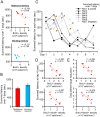A behavioral task with more opportunities for memory acquisition promotes the survival of new neurons in the adult dentate gyrus
- PMID: 29743494
- PMCID: PMC5943398
- DOI: 10.1038/s41598-018-25331-w
A behavioral task with more opportunities for memory acquisition promotes the survival of new neurons in the adult dentate gyrus
Abstract
It has been suggested that the dentate gyrus, particularly its new neurons generated via adult neurogenesis, is involved in memory acquisition and recall. Here, we trained rats in two types of Morris water maze tasks that are differentially associated with these two memory processes, and examined whether new neurons are differently affected by the two tasks performed during the second week of neuronal birth. Our results indicate that the task involving more opportunities to acquire new information better supports the survival of new neurons. Further, we assessed whether the two tasks differentially induce the expression of an immediate early gene, Zif268, which is known to be induced by neuronal activation. While the two tasks differentially induce Zif268 expression in the dentate gyrus, the proportions of new neurons activated were similar between the two tasks. Thus, we conclude that while the two tasks differentially activate the dentate gyrus, the task involving more opportunities for memory acquisition during the second week of the birth of new neurons better promotes the survival of the new neurons.
Conflict of interest statement
The authors declare no competing interests.
Figures








References
-
- Gage, F. H. Mammalian neural stem cells. Science287, 1433–1438, doi:8300 (2000). - PubMed
Publication types
MeSH terms
Substances
LinkOut - more resources
Full Text Sources
Other Literature Sources
Medical

